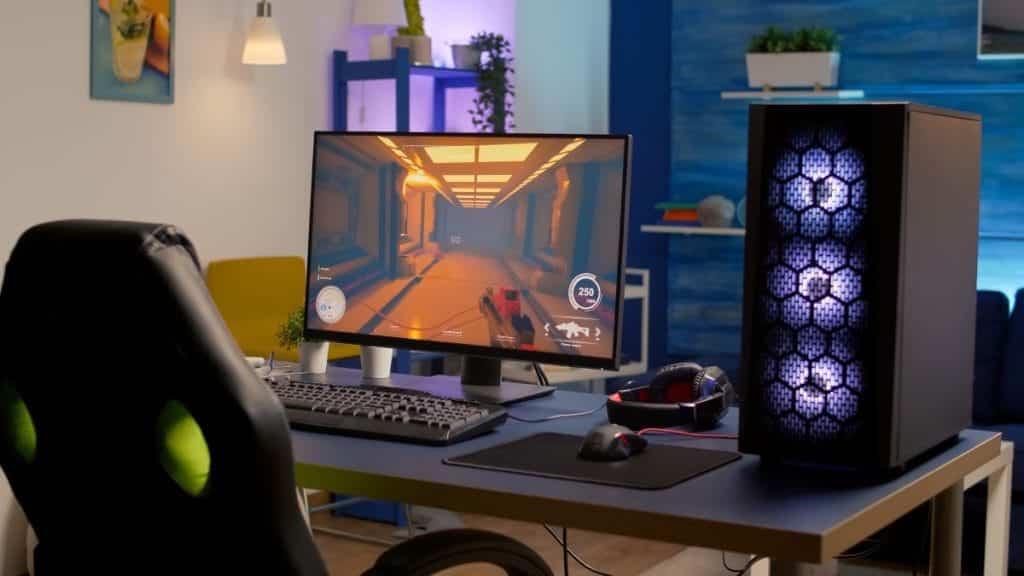Gaming monitors in 2025 have evolved dramatically, offering a variety of advanced technologies that cater to different budgets and performance needs. If you are aiming for a smooth gaming experience, a crisp display, or a deep level of immersion, the right monitor can give you a competitive edge and enhance overall enjoyment. In this guide, we will explore the essential features you should consider before buying a gaming monitor, and we will present specific recommendations tailored to different price ranges.
1. Introduction
“Gaming monitors in 2025 have evolved dramatically, offering a range of advanced technologies that cater to diverse budgets and performance needs.”
Modern gamers face a wealth of choices in the monitor market. Manufacturers have responded to high demand by developing new panel technologies, advanced backlighting systems, and cutting-edge features to ensure that every type of gamer finds a display that matches their style. Not only do these monitors boast faster refresh rates and higher resolutions than ever, but they also incorporate improved HDR support, refined color accuracy, and more ergonomic designs.
Purpose of the Guide
You might wonder which brand or model is worth your investment. This guide helps you navigate the many available options by breaking down specs such as resolution, refresh rate, and adaptive sync. Ultimately, our goal is to simplify your buying decision so you can focus on your gaming adventures rather than scrolling through endless product pages.
What to Expect from Gaming Monitors in 2025
You can expect a surge in ultrawide and curved form factors, mini-LED backlights, and displays that reach 360Hz or higher. Additionally, 4K resolution is becoming more mainstream, and 8K is slowly entering the conversation for extremely high-end setups. Rapid innovation in connectivity also means you will see more monitors with HDMI 2.1, DisplayPort 2.1, and USB-C ports. These technologies ensure compatibility with modern gaming consoles, next-generation graphics cards, and other peripherals.
2. Understanding Gaming Monitor Basics
“Before exploring specific models, readers should understand fundamental display features that influence gaming performance and visual quality.”
When choosing a gaming monitor, it helps to understand technical terms and core features. This section unpacks the essentials to ensure you make an informed decision.
Resolution and Screen Sizes
Resolution determines how many pixels a screen can display. Common resolutions include:
- 1080p (Full HD): This is still a reliable and cost-effective choice. It is ideal for budget or mid-range setups, especially if you prefer high frame rates without upgrading to a pricey graphics card.
- 1440p (QHD): This stands for Quad High Definition. It offers a substantial improvement in clarity over 1080p without the hardware demands of 4K.
- 4K (UHD): Ultra High Definition packs roughly four times the pixels of 1080p. Although it delivers stunning visuals, you need a powerful PC to maintain smooth frame rates.
- 8K: At the extreme high end, 8K is not yet mainstream. However, a few monitors do exist that offer incredibly detailed images.
Screen size directly affects pixel density. A larger 1080p display can sometimes appear less sharp than a smaller 1440p monitor, so keep viewing distance and personal preference in mind. Gamers who love immersive experiences may also favor ultrawide displays that add extra width.
Panel Technologies
Three major panel types—IPS, TN, and VA—are most common:
- IPS (In-Plane Switching): IPS panels provide excellent color accuracy and wide viewing angles. Competitive gamers once avoided IPS panels due to slower response times, but modern IPS monitors often match or surpass TN in responsiveness.
- TN (Twisted Nematic): TN panels feature very fast response times and are typically more budget-friendly. However, color representation and viewing angles can be weaker compared to IPS or VA.
- VA (Vertical Alignment): VA panels offer deeper blacks, high contrast, and good color performance. They can be slower in response time, although many newer VA gaming monitors have caught up significantly.
- OLED and Mini-LED: Some premium monitors now include OLED or mini-LED backlighting. OLED provides perfect blacks and exceptional color fidelity, whereas mini-LED improves local dimming and HDR performance.
Refresh Rates and Response Times
A monitor’s refresh rate, measured in hertz (Hz), tells you how many times the screen updates per second. Standard monitors often feature 60Hz, but gaming monitors usually offer 120Hz, 144Hz, 240Hz, or even 360Hz. A higher refresh rate delivers smoother motion and more responsive gameplay.
Response time is measured in milliseconds (ms) and indicates how quickly a pixel shifts from one color to another. A lower response time (e.g., 1ms or 2ms) reduces motion blur and ghosting, which are critical when playing fast-paced shooters or racing games.
Adaptive Sync Technologies
Screen tearing occurs when the monitor’s refresh rate fails to synchronize with the game’s frame rate. To combat this, adaptive sync solutions have emerged:
- G-Sync: NVIDIA’s proprietary solution that works best with NVIDIA graphics cards.
- FreeSync: AMD’s version, which is typically more widespread and often cheaper to implement.
- VRR (Variable Refresh Rate): A standard in newer consoles like the Xbox Series X and PlayStation 5, though they usually adopt FreeSync as their underlying tech.
Adaptive sync ensures smooth performance and eliminates visual artifacts, making gameplay more immersive and comfortable.
3. Key Considerations for Choosing a Gaming Monitor
“Budget, gaming style, and visual preferences should guide your choice of gaming monitor in 2025.”
It’s easy to get lost in model names and technical jargon. Nonetheless, focusing on what truly matters for your setup can streamline the selection process.
Budget vs. Performance
If you have a limited budget, investing in a high refresh rate 1080p display might be more beneficial than getting a low refresh rate 1440p or 4K monitor. Conversely, if you have the means, a 4K display with a 120Hz or 144Hz refresh rate can ensure a future-proof experience. Carefully weigh how much money you want to spend against the performance and visual fidelity you expect.
Genre-Specific Needs
Not all monitors are equally suitable for every gaming genre:
- Fast-Paced FPS (First-Person Shooters): High refresh rates and low response times matter most.
- RPGs and Strategy Games: Enhanced color accuracy, higher resolutions, and immersive visuals can be more valuable.
- Simulation and Racing: Wider screens and curved monitors often shine here, as they expand your field of view.
By identifying the genres you play frequently, you can decide which features take precedence.
Ergonomic Design and Build Quality
Long gaming sessions can strain your neck and back if the monitor lacks adjustability. Look for stands that let you pivot, tilt, swivel, or adjust the height to find the most comfortable viewing position. Also, consider how sturdy the stand is if you don’t plan on using a VESA mount.
Connectivity and Compatibility
In 2025, you will likely see widespread adoption of:
- HDMI 2.1: This enables up to 4K at 120Hz or more on consoles and PCs that support it.
- DisplayPort 2.1: DisplayPort often features higher bandwidth than HDMI, especially for PC use at ultra-high resolutions and refresh rates.
- USB-C: Some monitors include USB-C for single-cable connectivity to laptops or other devices.
If you plan to connect your monitor to multiple systems—like a gaming PC and a console—having the right ports is crucial.
4. Best Budget-Friendly Gaming Monitors (Under $300)
“Affordable gaming monitors in this price range can still deliver smooth action for most games without breaking the bank.”
You don’t need to spend a fortune to enjoy a decent gaming display. Many manufacturers now produce budget-friendly monitors that feature respectable refresh rates and acceptable color performance.
Top Picks and Their Standout Features
- Budget 1080p High-Refresh Monitor: Look for models that offer 1080p resolution with a 120Hz or 144Hz refresh rate. These are great for competitive gaming since they minimize motion blur.
- VA Panel Alternative: A few VA-based monitors provide deeper blacks and a satisfying contrast ratio, which can enhance story-driven titles.
Expect sturdy but basic stands that lack extensive adjustability. You might also see fewer ports than mid-range or premium counterparts.
Pros and Cons of Budget Models
- Pros:
- Lower cost, more approachable for newcomers.
- Modern budget monitors often include adaptive sync.
- Typically faster refresh rates than older 60Hz displays.
- Cons:
- Reduced color accuracy compared to pricier IPS or OLED models.
- Build materials and stand quality might be less robust.
- Limited HDR performance, if any.
Who Should Consider These Monitors
If you’re an entry-level gamer, a student on a tight budget, or someone upgrading from an older 60Hz screen, these monitors can substantially improve your gaming experience. Moreover, those who focus on esports titles like Counter-Strike: Global Offensive or Valorant can still enjoy fluid gameplay on these displays.
5. Mid-Range Marvels ($300–$600)
“Mid-range gaming monitors in 2025 strike an ideal balance between affordability and advanced features.”
Many gaming enthusiasts find their sweet spot in this price bracket. Not only do these displays offer improved resolutions or higher refresh rates, but they also feature better color accuracy and more stylish designs.
Why Mid-Range is a Sweet Spot
Spending between $300 and $600 usually gets you:
- 1440p resolution (QHD) or a 1080p monitor with a refresh rate of 240Hz or more.
- Upgraded panel quality (IPS or advanced VA), leading to enhanced visuals.
- Reliable adaptive sync implementations that reduce tearing and stuttering.
This bracket also tends to feature a wider range of screen sizes, from 24-inch options to 32-inch or larger displays.
Recommended Mid-Range Models
- 1440p IPS Monitors: These provide crisp visuals and excellent color reproduction. They typically run at 144Hz or 165Hz.
- High-Refresh 1080p Monitors: Some mid-range models go up to 240Hz or 360Hz. These cater to players who demand the absolute lowest latency.
- Curved VA Screens: If you crave deeper contrast, a curved VA monitor at 1440p can offer an engaging experience without costing a fortune.
Pros and Cons of Mid-Range Monitors
- Pros:
- Better build quality and design features.
- More consistent color accuracy and broader viewing angles.
- Future-proof for several years, especially if you choose a 1440p model.
- Cons:
- Premium features like OLED or advanced HDR remain rare.
- Might still require a powerful graphics card for 1440p gaming at high refresh rates.
Who Should Opt for Mid-Range
If you are a passionate gamer who values both performance and visual fidelity, this category is ideal. It’s also suitable for streamers or content creators who need more screen real estate and color accuracy for editing tasks or software overlays.

premium gadget
29$
This high-quality device features state-of-the-art technology with an ergonomic design, ensuring you experience comfort and efficiency. It integrates seamlessly into your daily routine, enhancing productivity. With unmatched versatility and user-friendliness, this product stands out as an essential tool. Upgrade your lifestyle and enjoy elevated functionality like never before!


